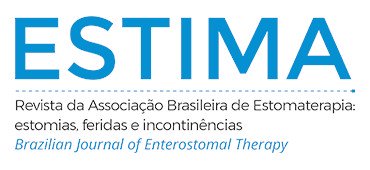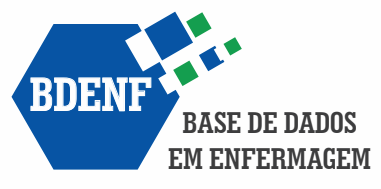“Sem Pressão”: application with guidelines for identification, staging and prevention of pressure injuries
Abstract
Objective: develop an application with guidance on the identification, staging and prevention of pressure injuries in adults. Method: the descriptive method used started with the search for applications in the area of pressure injuries on the Google © and Apple © platforms. Afterwards, the content was developed, based mainly on the recommendations of the National Pressure Injury Advisory Panel. A prototype was created at www.fábricadeaplicativos.com.br and sent for evaluation of form and content. Six health professionals completed a questionnaire evaluating the application and two of them suggested changes. The application was adequate to the suggestions and reassessed by three stomatherapist nurses who did not suggest changes. Results: the application was developed on the “application factory” website and named “Sem Pressão” (No Pressure), with seven tabs. Conclusion: the application was created with guidelines on identification, staging and prevention of pressure injuries in adults, and made available for free download.
Downloads
Metrics
References
European Pressure Ulcer Advisory Panel, National Pressure Injury Advisory Panel and Pan Pacific Pressure Injury Alliance. Prevention and treatment of pressure ulcers/injuries: clinical practice guideline. the international guideline. Emily Haesler (Ed.). EPUAP/NPIAP/PPPIA: 2019.
Caliri MH, Santos VL, Mandelbaum MH, Costa IG. Classificação das lesões por pressão – Consenso NPIAP 2016 – adaptação cultural. Publicação oficial da Associação Brasileira de Estomaterapia (SOBEST) e da Associação Brasileira de Enfermagem em Dermatologia (SOBENDE). 2016. [Acesso em 01 dez 2016]. Disponível em: http://sobest.org.br/textod/35.
Black JM, Cuddigan JE, Walko MA, Didier LA, Lander MJ, Kelpe MR. Medical device related pressure ulcers in hospitalized patients. International Wound Journal. 2010; 7: 358–65. Disponível em: DOI: 10.1111/j.1742-481X.2010.00699x
Black JM, Kalowes P. Medical device-related pressure ulcers. Chronic Wound Care Management and Research. 2016; 3: 91-9. Disponível em: DOI: https://doi.org/10.2147/CWCMR.S82370
Barbosa JM; Salomé GM. Ocorrência de lesão por pressão em pacientes internados em um hospital-escola. ESTIMA, Braz. J. Enterostomal Ther., 2018; 16: e2718. https://doi.org/10.30886/estima.v16.523_PT.
Constantin AG; Moreira APP; Oliveira JLC; Hofstätter LM; Fernandes LM. Incidência de lesão por pressão em unidade de terapia intensiva para adultos. ESTIMA, Braz. J. Enterostomal Ther., 2018; 16: e1118. doi: 10.1030886/estima. v16.454_PT
Pittman J, Beeson T, Kitterman J, Lancaster S, Shelly A. Medical device–related hospital-acquired pressure ulcers. Development of an evidence-based position statement. J Wound Ostomy Continence Nurs. 2015;42(2):151-4. Disponível em: DOI: 10.1097/WON.0000000000000113
Mazzo A, Miranda FB, Meska MH, Bianchini A, Bernardes RM, Pereira Junior GA. Teaching of pressure injury prevention and treatment using simulation. Esc. Anna Nery 2018;22(1). Disponível em: DOI: 10.1590/2177-9465-ean-2017-0182
Galhardo VA, Magalhães MG, Blanes L, Juliano Y, Ferreira LM. Health-related quality of life and depression in older patients with pressure ulcers. Wounds 2010;22(1):20–6. Disponível em: https://www.woundsresearch.com/content/health-related-quality-life-and-depression-older-patients-with-pressure-ulcers
Chacon JM, Blanes L, Borba LG, Rocha LR, Ferreira LM. Direct variable cost of the topical treatment of stages III and IV pressure injuries incurred in a public university hospital. J Tissue Viability. 2017; 26(2):108-12. Disponível em: DOI: 10.1016/j.jtv.2016.12.003
Dealey C, Posnett J, Walker A. The cost of pressure ulcers in the United Kingdom. J Wound Care. 2012; 21(6):261-6. Disponível em: DOI: 10.12968/jowc.2012.21.6.261
Vêscovi SJB, Caniçali PC, Sant’Anna HC, Bringuete MEO, Rohr RV, Prado TN, et al. Mobile application for evaluation of feet in people with diabetes mellitus. Acta Paul Enferm. 2017;30(6):607- 13. https://doi.org/10.1590/1982-0194201700087
Rouse M. mHealth in: TechTarget [internet]. [Acesso em 30 out 2016]. Disponível em: http://searchhealthit.techtarget.com/definition/mHealth
Sving E, Fredriksson L, Gunningberg L, Mamhidir A-G. Getting evidence-based pressure ulcer prevention into practice: a process evaluation of a multi-faceted intervention in a hospital setting. J Clin Nurs. 2017; 26:3200-11. Disponível em: DOI: 10.1111/jocn.13668
Rodrigues JJ, Pedro LM, Vardasca T, Fonseca F, Torre-Díez I, Martins HM. Mobile health platform for pressure ulcer monitoring with electronic health record integration. Health Informatics J. 2013;19(4): 300–11. Disponível em: DOI: 10.1177/1460458212474909
Pereira FG; Frota NM; Silva DV; Sousa LM, Almeida JC; Cysne Filho FM. Avaliação de aplicativo digital para o ensino de sinais vitais. Rev Min Enferm. 2017; 21:e1034. Disponível em: http://www.reme.org.br/artigo/detalhes/1170. Acesso em fev 2017. DOI: http://www.dx.doi.org/10.5935/1415-2762.20170044
Blanes L, Ferreira LM. Prevenção e tratamento de úlcera por pressão. 1ª ed. Rio de Janeiro: Atheneu. 2014.
Ferreira FK, Song EH, Gomes H, Garcia EB, Ferreira LM. New mindset in scientific method in the health field: design thinking. Clinics. 2015;70(12):770-2. Disponível em: DOI: 10.6061/clinics/2015(12)01
Coyer F, Tayyib N. Risk factors for pressure injury development in critically ill patients in the intensive care unit: a systematic review protocol. Syst Rev. 2017 Mar 20;6(1):58. Disponível em: DOI: 10.1186/s13643-017-0451-5.
Association of periOperative Registered Nurses (AORN) [homepage]. Position statement on perioperative pressure ulcer prevention in the care of the surgical patient. 2016. Disponível em: https://www.aorn.org/guidelines/clinical-resources/tool-kits/prevention-of-perioperative-pressure-injury-tool-kit. Acesso em out 2017.
Misra S, Lewis TL, Aungst TD. Medical application use and the need for further research and assessment for clinical practice: creation and integration of standards for best practice to alleviate poor application design. JAMA Dermatol. 2013;149(6):661-2. Disponível em: DOI: 10.1001/jamadermatol.2013.606
Tallier PC, Reineke PR, Asadoorian K, Choonoo JG, Campo M, Wallen CM. Perioperative registered nurses knowledge, attitudes, behaviors, and barriers regarding pressure ulcer prevention in perioperative patients. Appl Nurs Res. 2017; (36):106-10. Disponível em: DOI: 10.1016/j.apnr.2017.06.009
Mercês JMR; Redeiro MMP. A importância dos dispositivos móveis como estratégia para a formação e desenvolvimento de profissionais de saúde. UERJ, 2016. Sociedade Brasileira de Educação à Distância. Disponível em: http://www.abed.org.br/congresso2016/trabalhos/306.pdf. Acesso em fev 2020.
Agu E, Pedersen P, Strong D, Tulu B, He Q, Wang L, et al. The smartphone as a medical device. 2013 IEEE International Workshop of Internet-of-Things Networking and Control (IoT-NC), New Orleans, LA, 2013 [Acesso em 01 dez 2016]; 48-52. Disponível em: http://ieeexplore.ieee.org/stamp/stamp.jsp?tp=&arnumber=6694053&isnumber=6694041.
Bullock A, Dimond R, Webb K, Lovatt J, Hardyman W, Stacey M. How a mobile app supports the learning and practice of newly qualified doctors in the UK: an intervention study. BMC Med Educ. 2015; 15(71): 1-6. Disponível em: DOI: 10.1186/s12909-015-0356-8
Downloads
Published
How to Cite
Issue
Section
License
Copyright (c) 2020 Rosana Siqueira Campos, LEILA BLANES, DENISE NICODEMO, LYDIA MASAKO FERREIRA

This work is licensed under a Creative Commons Attribution 4.0 International License.

























